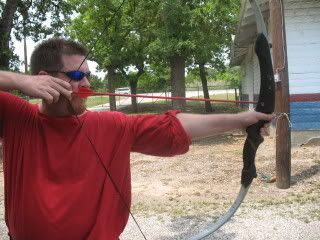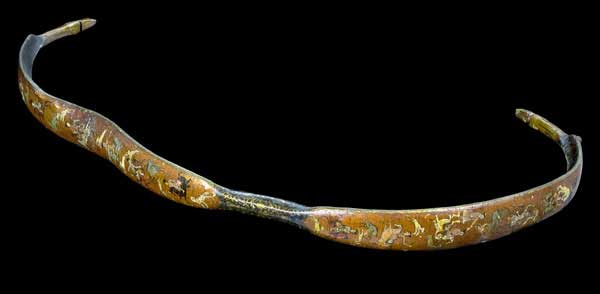Bow

Bow
Includes bows and crossbows used to fire arrows or bolts. They are not projectile weapons themselves but are used exclusively with Arrows.
- The maximum limit for a bow’s pull is 35 pounds with a maximum 28” draw length.
- Crossbows are limited to no more than 450 inch-pounds.
- No compound bows are allowed.
- At 20’ or less bows must be no more than half drawn.
- Crossbows do not have to be half drawn within 20’.
- If hit by a weapon, the bow is destroyed.
Arrow
Includes bolts and any other similar items. NOTE: Improperly constructed or maintained arrows can pose a serious safety hazard. Before building your fist arrows take the time to study an online construction tutorial or practice with an experienced player.
Shafts
- May be fiberglass, aluminum, plastic, or graphite.
- Wood shaft are only allowed if covered in a minimum of 4 mils of plastic tape or equivalent.
- Shaft must have any real arrow head or tip removed.
- The tip of shaft must be built up to at least 0.5” in diameter in a solid manner such as:
- Wrapping in duct tape and capping with a penny.
- Affixing a washer into the shaft with a glued-in screw.
- Other similar methods.
Heads
- Must be 2.5” in diameter.
- Front and side must be Strike-Legal.
- Must include a minimum of 2” of foam in front of the shaft of the arrow.
- The 0.5” of foam immediately after the end of the shaft must be closed-cell.
- Foam must be firm but compressible, and not able to deform around the arrow shaft on impact.
- Very soft foams such as couch cushion do not count towards the required 2” minimum of foam.
- May not be drawn beyond 28”.
- Fletching and nocks, if present, must be in good repair.
- Heads should be checked regularly for degrading foam.
- Must be clearly labeled with their owner’s name.
- . Arrows without labels will never be allowed on the field.
- Using arrows without labels can result in immediate suspension from the field.
- Must have a cloth cover on the head.
- Properly colored strips may be used in lieu of colored head covers to denote special arrow status.
- Normal arrows may not be covered in any of the colors reserved for special arrow.
- Reserved colors are: yellow, red, green, purple, and grey.
- Broken or poorly mended arrows are not to be used.
- Must strike point first to score a hit.
- Affects all targets struck while in motion.
- Hits from arrows are Armor Breaking.
- Hits from arrows are Weapon Destroying.
- Like any other equipment arrows may only be used by their owner unless the owner grants specific permission for another player to use their arrows.
- The owner of an arrow is responsible for the safety of the arrow even if fired by another player.
- special arrow may never be shared.
- Swinging at an arrow in flight is illegal.
- Arrows may only be passively blocked by placing an object in the flight path.
Who uses this weapon?
Bows are used by Archers, Assassin, Scout, and Druids using their Ranger ability .
From more information on Arrows see the Projectiles Section.
About Bows
A bow is a weapon that projects arrows powered by the elasticity of the bow. As the bow is drawn, energy is stored in the limbs of the bow and transformed into rapid motion when the string is released, with the string transferring this force to the arrow. Bows are used for hunting and sport (target shooting), and as a weapon of war.

The technique of using a bow is called archery. Someone who makes bows is known as a bowyer, and one who makes arrows a fletcher. Together with the atlatl and the sling , the bow was one of the first ranged weapons or hunting tools which used mechanical principles, instead of relying solely on the strength of its user.
The development of gunpowder, muskets, and the growing size of armies (and their consequent demand for less-trained levies) slowly led to the replacement of bows as weapons of war, supplanted by firearms, which were simpler for conscripts to learn and use, causing bows to be relegated to sport and hobby use.
Regardless of its other construction, the basic elements of a bow are a pair of curved elastic limbs, typically of wood, connected by a string. By pulling the string backwards the archer exerts compressive force on the inner section, or belly, of the limbs as well as placing the outer section, or back, under tension. While the string is held, this stores the energy later released in putting the arrow to flight. The force required to hold the string stationary when pulled is often used to express the power of a bow, and is known as its draw weight. A higher draw weight is associated with a more powerful bow, which is able to project arrows heavier, faster, or a greater distance.
In bows drawn and held by hand, the maximum draw weight is determined by the strength of the archer. The maximum distance the string could be displaced and thus the longest arrow that could be loosed from it, a bow’s draw length, is determined by the size of the archer. For bows drawn and held mechanically, the maximum draw weight was a matter of engineering. The mechanical force required to draw the string was mainly limited by the time required to do so.
Links
- make a bow from a sapling by Jon Jeffer
See Oznog.